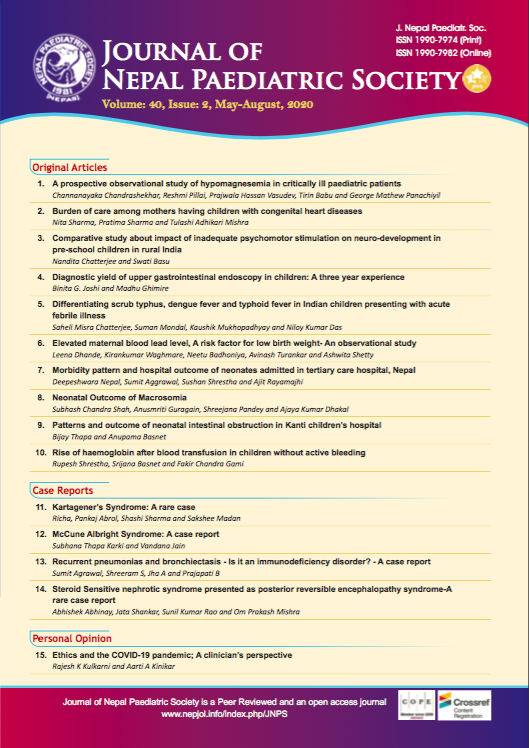Differentiating Scrub Typhus, Dengue Fever and Typhoid Fever in Indian Children Presenting with Acute Febrile Illness
DOI:
https://doi.org/10.3126/jnps.v40i2.29319Keywords:
acute febrile illness, dengue, scrub typhus, typhoidAbstract
Introduction: The disease spectrum of dengue, scrub typhus and typhoid presenting as acute febrile illness is often a diagnostic dilemma to the clinician. The purpose of this study is to compare the clinical features and laboratory parameters of children suffering from typhoid, dengue and scrub typhus and use these parameters in early identification of scrub typhus before conclusion is made from serological diagnosis.
Methods: A retrospective observational analytical study was conducted among children presenting with acute febrile illness in a tertiary care level hospital. Over the period of one year 113 cases were identified of which 39 were dengue, 44 were typhoid and 30 were scrub typhus.
Results: The mean age of the children was 7.45 ± 2.98 years, median was eight with an interquartile range of six to ten years. The male to female ratio was 1.3:1. Symptoms of vomiting (61.54%), headache (46.15%) and hepatomegaly (47.37%) were significantly higher among children with dengue fever. A significantly higher number of children with scrub typhus fever had temperature above 40°C. The incidence of low haemoglobin, raised C reactive protein, raised ALT and low albumin levels were significantly higher in them. Children with acute febrile illness having temperature > 40°C, absolute neutrophil/lymphocyte ratio > 2 early in the illness were more likely to suffer from scrub typhus with relative probability ratio (RPR) of 25.68 and 10.57 respectively (p < 0.001). Children with WBC < 5000/mm3 were more likely to be suffering from dengue with RPR of 10.60 (p < 0.001).
Conclusion: Children with acute febrile illness with temperature > 40°C and absolute neutrophil/lymphocyte ratio > 2 early in the illness were more likely to be suffering from scrub typhus.
Downloads
Downloads
Published
How to Cite
Issue
Section
License
Authors who publish with this journal agree to the following terms:
Authors retain copyright and grant the journal right of first publication with the work simultaneously licensed under a Creative Commons Attribution License that allows others to share the work with an acknowledgement of the work's authorship and initial publication in this journal.
Authors are able to enter into separate, additional contractual arrangements for the non-exclusive distribution of the journal's published version of the work (e.g., post it to an institutional repository or publish it in a book), with an acknowledgement of its initial publication in this journal.
Authors are permitted and encouraged to post their work online (e.g., in institutional repositories or on their website) prior to and during the submission process, as it can lead to productive exchanges, as well as earlier and greater citation of published work (See The Effect of Open Access).



